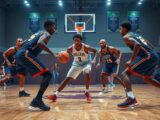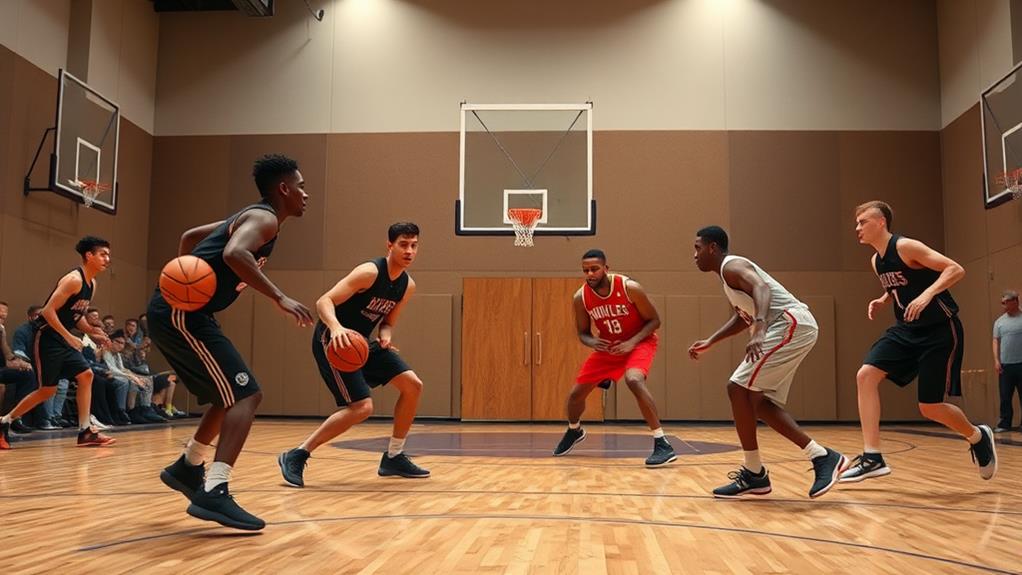
How to Implement the Read and React Offense
September 22, 2024To implement the Read and React offense, start by introducing its core principles to your team. Focus on player movement, spacing, and effective communication. Begin with basic layers like Pass and Cut before progressing to more complex actions. Use drills that emphasize teamwork and quick decision-making. Encourage players to make hard cuts and exploit defensive weaknesses with smart spacing. Make sure to invest time for everyone to master the system, as consistent practice will lead to better execution. There's a wealth of strategies and resources that can help you enhance your team's understanding of this dynamic offense.
Overview of the Read and React Offense
The Read and React Offense is a dynamic system designed to elevate both individual and team performance on the basketball court. Developed by Coach Rick Torbett, this approach enhances player movement, spacing, and decision-making, moving away from rigid, set plays. Instead, it fosters a fluid style of play, allowing players to adapt to various game situations and formations, such as 5-out, 4-out, or 3-out.
Much like the evolution of soccer from various ancient games to the modern structured form that's recognized today, the Read and React offense encourages players to develop their skills through adaptive strategies and teamwork, emphasizing historical foundations that contribute to success.
One of the key features of the Read and React offense is its structured curriculum, providing multiple layers of complexity that cater to different skill levels. This layered approach promotes teamwork and communication, essential elements for successful execution.
As players learn to read the defense, they uncover scoring opportunities by prioritizing movement and passing over isolation plays. Foundational concepts like Pass and Cut form the basis of the system, while advanced strategies, such as Post Screens and Circle Movement, further enhance player creativity.
Strengths of the Offense
The Read and React Offense shines because of its adaptability to different team styles and compositions.
This tactical flexibility allows for seamless integration of various player roles and formations such as 4-4-2 or 3-5-2.
You can easily adjust your alignments, whether you prefer a 3-out, 4-out, or 5-out setup.
This flexibility, combined with enhanced player dynamics, keeps defenses guessing and allows your team to thrive.
Adaptability to Team Styles
Adapting the Read and React Offense to your team's unique style can greatly enhance your gameplay. This offense is incredibly adaptable, allowing you to employ various formations like 3-out, 4-out, or 5-out, catering to your players' strengths and skill sets.
By emphasizing player movement and teamwork, the Read and React fosters an environment where all players contribute, markedly improving team dynamics.
The flexibility of this system enables you to customize the offense according to your team's philosophy. You can choose specific layers of the Read and React that align with your gameplay strategies, making it easier to exploit mismatches.
As players learn progressively, they can gradually tackle more complex concepts, which is particularly beneficial for teams with varying levels of experience and basketball IQ.
Furthermore, the constant motion and unpredictability inherent in the Read and React create challenges for defenses, leading to valuable scoring opportunities.
Enhanced Player Dynamics
Implementing the Read and React offense transforms how players interact on the court, enhancing team dynamics and individual contributions. This offensive system promotes constant player movement, which not only improves spacing but also makes it challenging for defenses to predict actions.
By emphasizing teamwork, players learn to read the defense and make quick decisions, considerably boosting their basketball IQ. This leads to more efficient scoring opportunities.
The versatility of the Read and React allows for seamless adaptation to different alignments, such as 3-out, 4-out, or 5-out, catering to each player's strengths and weaknesses.
Prioritizing cutting and passing over dribbling minimizes turnovers and fosters a collaborative playing style. As a result, shot distribution becomes more equitable among players.
The layered approach to skill development guarantees that players progress at their own pace, making the offense adaptable to varying experience levels.
This method builds confidence in individual abilities, allowing each player to contribute meaningfully. Overall, the Read and React offense enhances player dynamics by encouraging active participation, improving teamwork, and fostering a deeper understanding of the game.
Weaknesses of the Offense
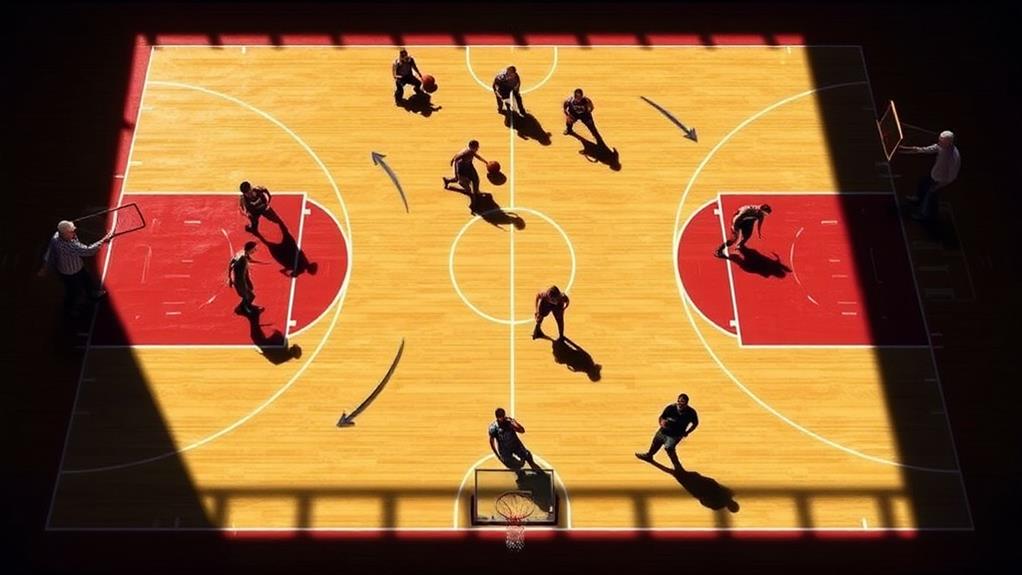
While the Read and React offense offers great potential, it does come with some challenges.
You'll need to invest significant time for your players to fully grasp each layer, which can be tough if practice time is limited. This approach requires a commitment to developing effective communication among players, as understanding one another's movements is essential for success.
Additionally, everyone on the team must commit to the system; mixing in other plays can throw off the learning process and hinder your success.
Time Investment Challenges
Mastering the Read and React Offense presents significant time investment challenges that can hinder a team's success. To fully grasp the intricacies of this system, players must commit to a rigorous learning process. The initial learning curve can feel intimidating, and without dedicated practice, foundational concepts may remain unclear.
Here are key challenges you might face:
- Extensive Learning: With 20 layers to master, players need consistent practice to understand each element.
- Commitment Issues: Mixing traditional plays with the Read and React can create confusion and stall implementation.
- Communication Breakdown: Clear communication about shot distribution is crucial; limiting top players' shot attempts can lead to frustration if not managed effectively.
- Adapting to Defenses: Without sufficient practice, executing the offense against prepared defenses can become a major hurdle.
To succeed, you'll need to invest time and effort into mastering these aspects. Emphasizing consistent practice and effective communication will help you navigate these challenges.
Commitment and Consistency Needed
Commitment and consistency are essential for the success of the Read and React Offense, yet many teams struggle to maintain these fundamental elements. To achieve successful implementation, both players and coaches must fully commit to mastering the system. Mixing plays from other offensive systems can derail progress, as it dilutes understanding of core principles.
Players need to invest significant practice time to overcome the initial learning curve, especially beginners who must grasp basic concepts before tackling more complex layers. This means regular, focused practice sessions that reinforce the offense's principles, ensuring everyone is on the same page.
Additionally, clear communication among players is imperative. Without it, some players may dominate touches while others are left out, which can limit shot attempts for top players and hinder overall team performance.
Consistency in practice and execution helps the team adapt to various defensive strategies. When players regularly engage with the offense, they develop the confidence needed to counteract well-coached defenses.
Ultimately, maintaining commitment and consistency will bolster your team's ability to effectively implement the Read and React Offense and lead to greater success on the court.
Key Offensive Layers
Implementing the Read and React Offense requires a deep understanding of its key layers, which serve as the building blocks for effective player movement and decision-making.
Each layer introduces specific skills that players must master to create a fluid offensive system. By integrating principles such as pressure and cover, teams can develop a more dynamic approach to offensive play.
Here are four essential layers to focus on:
- Pass and Cut: This foundational layer teaches players to make hard cuts to the basket immediately after passing, opening up scoring opportunities.
- Post Pass and Cut: With this layer, post players learn consistent cutting rules, offering both low and high cut options that enhance offensive flexibility.
- Dribble At Back Cuts: This layer emphasizes executing backdoor cuts in response to dribble actions, fostering teamwork and effective spacing on the court.
- Gradual Integration: Coaches can select and implement layers based on their team's needs, allowing for a smooth shift as players become more comfortable with these concepts.
Advanced Layers and Strategies
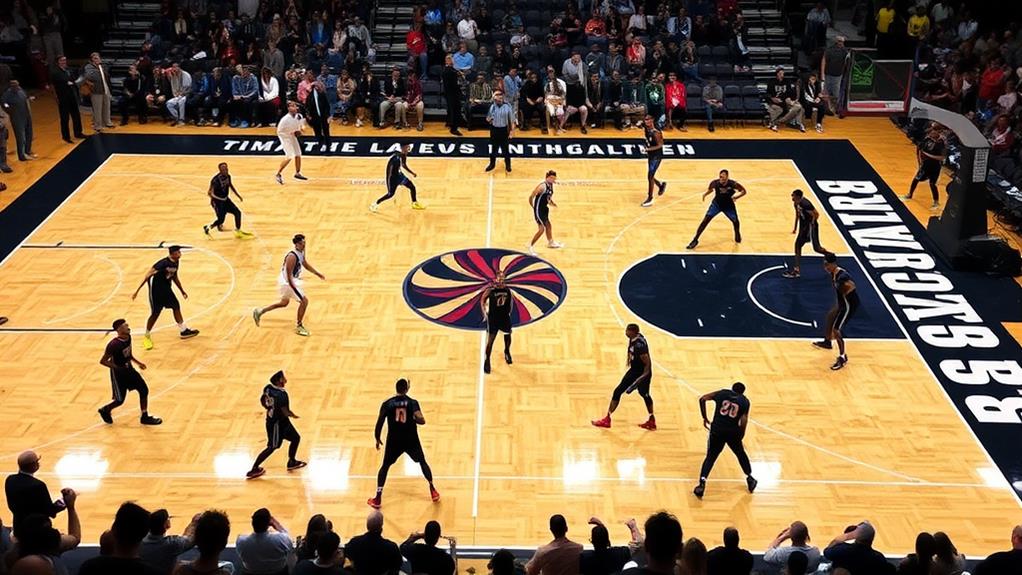
The Read and React offense offers advanced layers and strategies that elevate your team's performance by adding complexity to your gameplay. By incorporating Layer #6, baseline penetration, you create scoring opportunities through weak-side passing options during drives. This approach keeps defenders guessing and opens up lanes for effective plays, similar to how defenders utilize defensive stance to maintain balance and react quickly.
Layer #7, pin and skip, is another powerful tool. It works against both zone and man defenses, quickly reversing the ball to create open shot opportunities. By combining these advanced layers, you can develop offensive strategies that enhance unpredictability, making it tougher for defenses to anticipate your next move.
Integrating breakdown drills into your practices is essential for refining vital skills like shooting technique, passing, and finishing. These drills help your players understand game dynamics and improve their ability to respond to various defensive situations.
As players adapt and learn to read the defense, you'll notice significant improvements in overall team performance.
Whether you're facing a tight zone or aggressive man-to-man defense, these advanced layers will give your team a competitive edge. Embrace the complexities of the Read and React offense to maximize your scoring potential.
Player Movement Techniques
Mastering player movement techniques is essential for success in the Read and React offense. These techniques not only enhance your effectiveness on the court but also create scoring opportunities through precise execution.
By incorporating effective soccer passing drills, players can improve their decision-making and spatial awareness, which are critical in a dynamic offensive strategy. Here are four key player movement techniques you should focus on:
- Cutting Hard: Always make aggressive cuts, especially with North-South cuts. They're more effective against defensive pressure, helping you maintain control of the play.
- Spacing: Maintain proper spacing to allow teammates room to operate. This gives you and your teammates better chances to exploit defensive weaknesses.
- Power Dribble: Use the Power Dribble to initiate dribble handoffs and roll to the basket. This promotes teamwork and keeps the offense fluid.
- Advanced Post Reactions: Train yourself to perform backdoor cuts when defenders overcommit. This maximizes scoring options for players in the short corner.
Implementation Strategies for Coaches
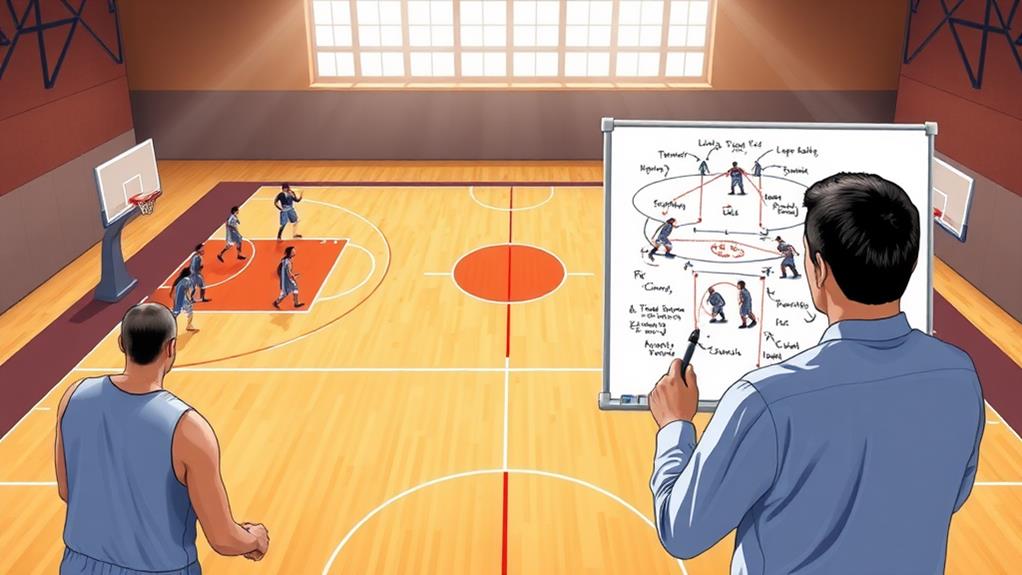
To effectively implement the Read and React offense, coaches should focus on introducing foundational layers step by step. Start with basic skills like Pass and Cut, guaranteeing players grasp these concepts before moving on to more complex actions like screens and additional cuts. Understanding the importance of essential skills and positions can further enhance player development and execution of the offense.
In the initial 15 minutes of practice, incorporate 3-player reaction drills to establish muscle memory and enhance responsiveness to movement and decision-making. As players become comfortable, shift through practice steps that include repetition drills (5 vs 0), semi-live scenarios (5 vs 5 with dummy defenders), and eventually full live play. This progression guarantees players can execute the offense in various game contexts.
Utilize resources from Better Basketball to provide visual aids, making it easier for players to understand how each layer builds on the previous one. Foster an environment of continuous learning by encouraging coaches to share experiences, reflect on practices, and adapt implementation strategies based on team performance and player feedback.
This collaborative approach not only strengthens understanding but also boosts overall team performance, guaranteeing everyone is on the same page as you implement the Read and React offense.
Learning Resources for Development
While exploring learning resources for developing the Read and React offense, you'll find an abundance of materials that can considerably enhance your coaching and player performance. Notable figures like Nera White and Cheryl Miller have paved the way for women's basketball, demonstrating the importance of strong offensive strategies and teamwork.
Here are four key resources to reflect upon:
- Better Basketball Guide: Immerse yourself in a detailed guide that offers in-depth strategies and layered learning approaches for teaching the Read and React system.
- Free Video Training: Access free video drills that help both coaches and players understand how to effectively implement each layer of the offense.
- Practice Drills: Utilize innovative drills in this free resource that focus on teamwork and effective communication among players as they learn to play offense.
- Community Engagement: Join a community platform where coaches at any level can share experiences and strategies, fostering collective growth in basketball knowledge.
Conclusion
To sum up, implementing the Read and React offense can transform your team's play. This flexible system allows players to read defenses and react accordingly, promoting teamwork and basketball IQ. Curiously, teams that adopt this offense often see a 10-15% increase in assists per game, showcasing its effectiveness in ball movement and player collaboration. By embracing this strategy, you'll not only elevate your players' skills but also enhance your team's overall performance on the court.

